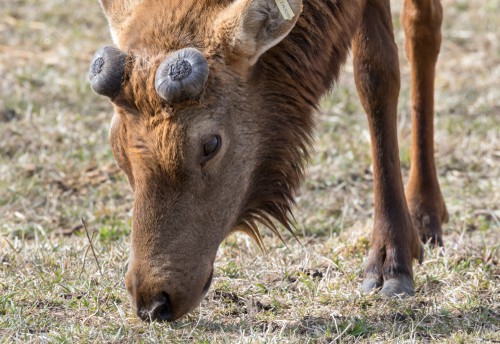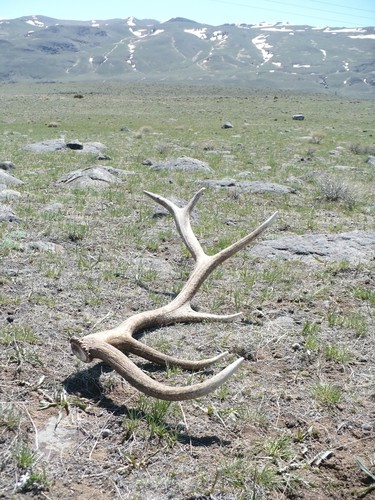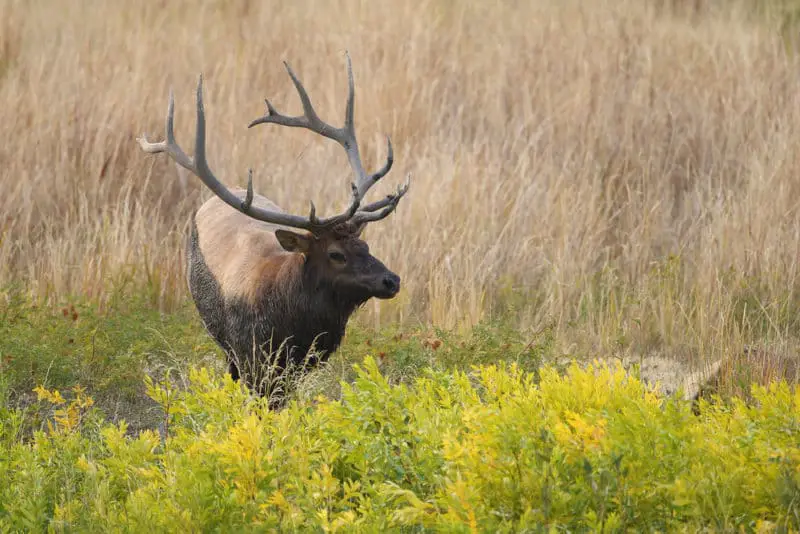Why Do Elk Shed Their Antlers?
Bull elk shed their antlers in the spring because hormone levels in their blood signal their bodies to do so. It’s more complicated than that, though. Elk, along with deer, moose, and caribou, are part of the Cervidae family. Cervids grow antlers, which they shed and regrow every year. The timing of antler growth and antler shedding in all cervids is regulated by the hormones in their blood. In turn, the hormone level in a bull elk’s blood is tightly correlated with the ratio of light to darkness within a 24-hour period or, in other words, the photoperiod.
Light travels the retina and along their optic nerve to stimulate their penal gland within their brain. In turn, the penal gland secretes melatonin. The amount of melatonin in the blood regulates other hormones, such as testosterone. Their testosterone level peaks during the fall breeding season. On the other hand, it’s at its lowest level from mid-March through the end of April. This is the time that they shed their antlers. A bull’s antlers form from two knob-like projections on the animal’s skull called pedicles. When his testosterone is at its lowest level, it signals his body to produce cells called osteoclasts that specialize in breaking down and reabsorbing bone. Osteoclasts form a zone of abscission between the antler and the pedicle. This is a layer where the bone has been dissolved. The antler falls off at this point, leaving the animal’s pedicle still attached to the skull.

Growing New Antlers
As the length of the photoperiod increases, hormones in the bull’s bloodstream again go to work, this time to signal that it’s time to build a new set of antlers. A person with a background in physiology will find this explanation overly simplified, but it will suffice for our purposes.
First, the bull grows a layer of shiny skin covered with fine short hairs called velvet over the open wounds over its pedicles. Velvet provides a covering for vascular action to deliver oxygen and nutrients to its growing antlers. Then, specialized cells called chondrocytes come into play to build the cartilaginous framework for the new antlers. The new antlers harden because specialized cells called chondroclasts reabsorb the cartilage, as other specialized cells called osteoblasts replace the cartilage with bone. When the bull has formed his hardened antlers, the blood flow to them ceases. Their velvet covering then dries up and dies. The bull then rubs the velvet off from his newly formed antlers.
All of these processes have been sent into action because of the length of the photoperiod. The photoperiod will next signal to the bull that it’s time to get ready for the mating season or the “rut.” During the rut, the testosterone in the bull’s bloodstream surges to the highest level it will reach during the year.
Scientific Experiments with Photoperiod and Antler Growth
In the 1950s, Zbigniew Jaczewski was one of the first to scientifically prove the correlation between the antler growth cycle and the photoperiod cycle. To do this, he kept some of his captive buck deer in a dark shed each afternoon in the summer. This simulated a shorter day and a longer night. The antlers on the deer receiving this treatment hardened, and they stripped their velvet off halfway through their growing period. The bucks then went into a false rut and became too aggressive to herd into the darkened shed. Back on a normal schedule, these bucks promptly shed their antlers and grew a new set during that summer. They then carried their new antlers and shed them at the regular time with the other bucks in the herd.
In the 1960s, Richard Goss carried out experiments with buck Sika deer. These animals were kept in enclosures, where the only light they were exposed to came from Florissant lamps. He found that by reversing the photoperiod to the exact opposite of what was going on outside, he made his deer switch their antler-growing cycle.
Mr. Goss also found that by shortening the length of the photoperiod cycle, he could make his deer grow up to three sets of antlers in a year. Then, taking the opposite approach, he doubled the length of the photoperiod cycle, and his bucks produced only one set of antlers in two years. Source
When Do Elk Shed Their Antlers?
Bull elk shed their antlers later than other members of the Cervidae family. They lose them anywhere from mid-March to late April. In contrast, deer begin dropping their antlers in January, while moose start losing theirs in mid-December.

Where Do Elk Shed Their Antlers?
Shed antler hunting has become very popular in the western United States. If you think you’d like to try it, you’ll need to go where the elk go. Look for shed elk antlers on their springtime feeding and bedding grounds or the trails leading to these places. You’ll find elk on the flats and foothills that lead up to their high country summer range at this time of year. Also, remember that the snow will first melt off of south and west-facing slopes in the spring because these areas receive more direct sunlight. Consequently, this is where the elk will be concentrated.
Some states regulate shed antler hunting, while others do not. Make sure that you are familiar with the rules on antler hunting in your state before going out into the field.
Also, never approach a herd of elk on their springtime feed grounds too closely. The animals are already under a lot of physiological stress at this time of year. If you cause them to run, you’ll be putting an even more significant strain on them. In the extreme, you could possibly even be killing already weakened animals.
Recent Posts
The only venomous snakes in Washington State are Northern Pacific Rattlesnakes. The Northern Pacific Rattlesnake (Crotalus oreganus oreganus) is a sub-species of the Western Rattlesnake. Anyone...
Skunks are not classified as true hibernators. But they go into a state of torpor when the weather gets cold. Skunks are light sleep hibernators, along with opossums, bears, and raccoons. ...

